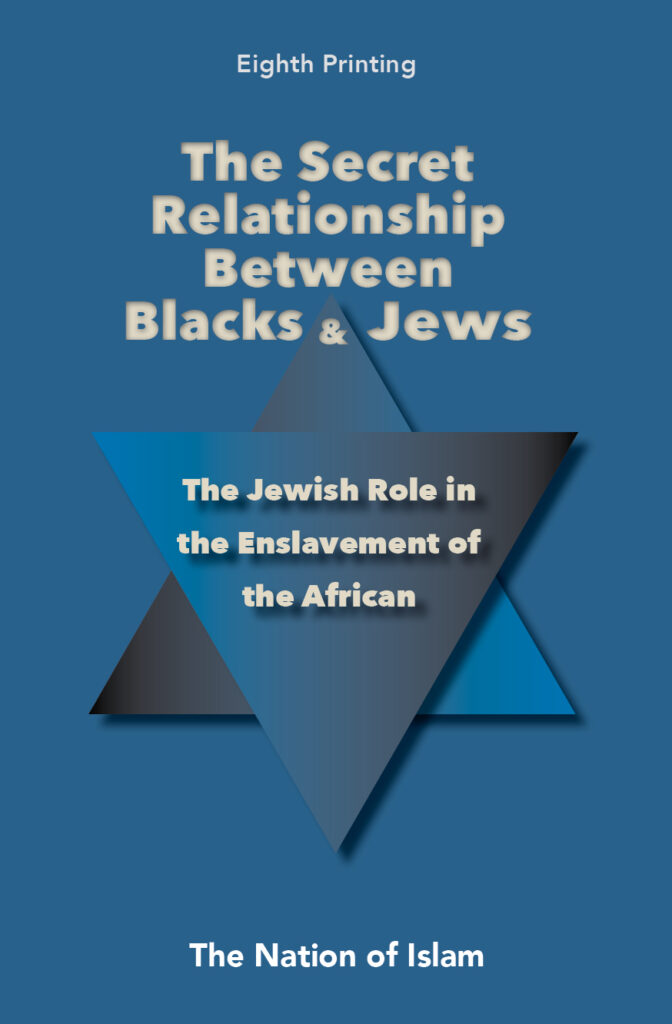Caleb Amilicar: Review: The Secret Relationship Between Blacks and Jews, Volume 1
Historical Research Department, Nation of Islam, 334 pages, 1991
By Caleb Amilicar, Truth Establishment Institute
Not surprisingly, The Secret Relationship Between Blacks and Jews when released after its fourth printing in 1994 established a presence in the scholastic realm, where new ideas are presented, discussed and researched. Compiled by the Historical Research Department, the book has undergone a quiet resurgence on college campuses across the United States. While considered by many to be an underground classic, the book has in fact influenced thought for an entire generation of students, thinkers and theorists.
Consider these words about the book written by Barry Mehler, founder and executive director of the Institute for the Study of Academic Racism:
“The book is meticulously, almost lovingly, researched and heavily footnoted. There is no question that the anonymous researchers who produced this book have scoured Jewish literature. As one who reads racist material for a living, this 334 page book appears to be a dazzling addition to the annals of anti-Semitic literature. I am sure that its influence and circulation will be impressive and long lasting.”
The Truth Establishment Institute agrees that its influence and circulation will be impressive and long lasting, but disagrees with his labeling of it as “anti-Semitic literature” as Mr. Mehler states. It is interesting that while giving praise to the quality of the research, he had apparently classified this book as “racist material” and therefore formed his opinion and judgement of the book based on that position.
On page iv the researchers for the Historical Research Department wrote the following:
“A substantial body of evidence that supports the findings herein was excluded by the editors and deemed to be from sources considered anti-Semitic and/or anti-Jewish.”
It is evident from that statement that the researchers conducted careful research without the disingenuous and deceptive aim, to create an anti-Semitic or racist publication.
Well packaged, the book contains 334 pages of fully documented text including 1,275 footnotes, from more than 3,000 sources. Most of the sources, if not all, were collected from Jewish historical literature. As a research document, the book is not what you would call an easy read, however, with a fully annotated index, and clearly descriptive sections and subject titles, the book is surprisingly easy to navigate. The editors detailed clearly all references consistently linked by sparse journalistic narratives intended to enhance clarity while not distracting the reader from the information contained within.
One area of note is the abolitionist movement, of which Jewish scholars ostensibly claim membership. On page 147 in a section clearly the Historical Research Department shows using Jewish sources, that those involved in the abolitionist movement were few, and those who did stand against the institution of slavery “were scorned and rebuked most harshly by their own brethren in the synagogue.”
There is an additional point of interest identified through the research of the Historical Research Department. It is shown that those who did stand against the spread of slavery did so because of the threat it presented to their jobs and economic well being. This is a central difficulty and one that cannot be easily countered by the Jewish thought control organizations, since many who decried this book as anti-Semitic, cited the fact that Jews were apart of the abolitionist movement as a defense. There is no denying that they were a part of the abolitionist movement. Similarly, there is no denying that members of the Jewish community were involved in the civil rights movement of the 1960’s, however, the motivation behind the involvement must be brought to light. Interestingly enough, their involvement appears motivated by self-interests and not compassion and concern.
In exhaustive detail, The Secret Relationship Between Blacks and Jews provides geographic records beginning with the infamous Columbus voyages, and dealing with Jews and slavery in Brazil, Surinam, Barbados, Curacao and Jamaica. Jewish Slavery in Colonial North America, the South, and Jewish involvement in the Civil War.
Jewish court records, port records and wills of Jewish slave owners were used. The names of ships, their owners and in many cases, their cargo, were listed and presented in an easy to understand format. Not only is the information easy to read, but using Jewish sources also eliminates the accusation of fraud—unless of course the Jewish scholars maintain that their research in this matter is shoddy and fraudulent.
Given the volatility of the subject, it is obvious why a book approaching this area would be controversial, however as the number of those having read the book has grown over the years, it has produced in many areas, as the editor’s note stated “an opportunity to develop a more equitable relationship between the families of man.”
One of the most controversial books of the decade, this book is one that you must own in order to be considered, up to date and well-educated regarding historical realities. The scholarly treatment of this subject by the Historical Research Department is unmatched.
*Barry Mehler, “African American Racism in the Academic Community.” First published in The Review of Education 15 # 3/4 (Fall 1993). Revised and republished as “Addressing the Problem of African-American Racism in Academia,” in Martyrdom and Resistance (Nov.-Dec. 1993)
Caleb Amilicar is a Research Fellow at the The Truth Establishment Institute TEI.
